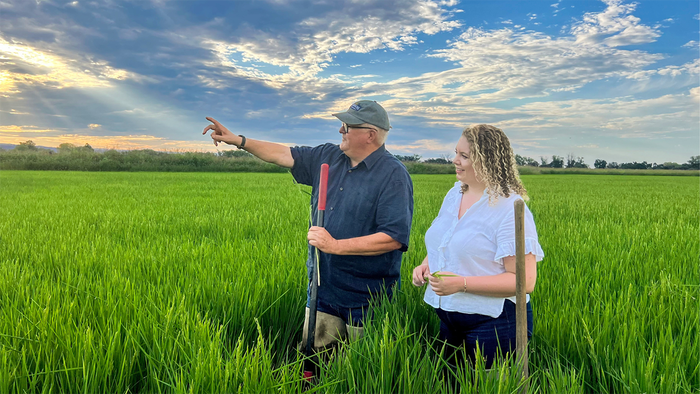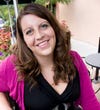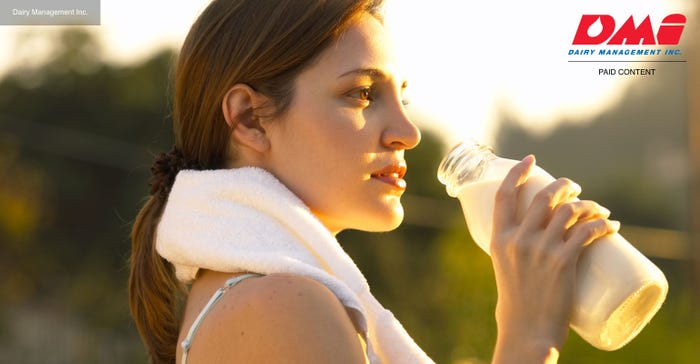Lundberg Family Farms leads ROC food brands with 70-plus rice productsLundberg Family Farms leads ROC food brands with 70-plus rice products
The California brand offers Regenerative Organic Certified rice in pouches, as cakes, with seasonings and more. Find out why the certification matters.
March 11, 2024

At a Glance
- With more than 70 Regenerative Organic Certified products, Lundberg Family Farms is the top ROC food brand in the U.S.
- More than 8,500 acres of Lundberg's rice fields are certified; the farms' leaders want to be 100% certified by 2027.
- The farms' flooded rice fields create a habitat for birds in the Pacific Flyway, a major migratory pathway.
What is old is new. For centuries, Indigenous cultures have employed regenerative practices. Now, regenerative agriculture is a hot topic, particularly in the natural and organic products community.
Lundberg Family Farms is becoming a bigger part of that conversation with its growing influence in regenerative agriculture: It's the top Regenerative Organic Certified food brand in the United States, the company announced recently.
This year, Lundberg Family Farms, which is headquartered in Richvale, California, will launch more than 70 products made with Regenerative Organic Certified rice.
“There's a lot of buzz around regenerative right now,” says Brita Lundberg, communications manager and fourth-generation farmer at Lundberg Family Farms. “It means a lot of different things to a lot of different people.”
A lot of people don't think regenerative agriculture has to be organic, Lundberg says.
“Some think it’s okay to grow cover crops and use chemicals to terminate that cover crop,” Lundberg says. Maybe those producers usually use six pesticides but have reduced that number to five—and still consider their practices to be regenerative, she says.
“It’s a step in the right direction,” Lundberg says. “And we want to applaud that improvement. But we want to make sure that regenerative is meaningful to consumers and retailers. We believe that third-party certification is essential to building consumer trust and holding the industry accountable for making meaningful change.”
The timing is also right for the industry to move towards organic products made using regenerative practices.
“We’re starting to see that sustainability isn't enough, that if we sustain where we are right now, it's not going to cut it,” Lundberg says. “There's a push to improve circumstances.”
For the past several years, Lundberg Family Farms has worked with the Regenerative Organic Alliance. It now grows 70% of California’s Regenerative Organic Certified rice, according to Lundberg.
“Our goal is that all of our organic rice is ROC by the year 2027,” says Bryce Lundberg, vice president of agriculture for Lundberg Family Farms. “We’re well on our way towards that.”

Bryce Lundberg, left, and Brita Lundberg believe regenerative agriculture practices are key to improving the planet. Credit: Lundberg Farms
What does regenerative agriculture mean to you?
Brita Lundberg: I’m sure you know, regenerative hasn’t been legally defined yet. Ask 10 different people what it means and you’ll probably get 10 different answers.
But if you ask us, it starts with organic. We see Regenerative Organic Certified as the gold standard, using USDA Organic as a baseline and then building on top of that.
We see regenerative organic as an extension of my great-grandpa Albert's dream of leaving the land better than he found it.
Why did you partner with Regenerative Organic Alliance (ROA) to become Regenerative Organic Certified?
Bryce Lundberg: We believe that organic standards exist in a continuum, with USDA organic being the floor. We believe organic farming starts with soil, building healthy soil which supports healthy plants, and healthy plants produce healthy food, which is our goal.
The Regenerative Organic Alliance is working hard to develop this area. We felt it was a natural for us because we believe in healthy soil, in social fairness and caring for animals with animal welfare. Those three pillars are often embodied by many farmers in the organic area
Is that unique?
Bryce: More and more, as large firms come into the organic area, they might just be going toward the base. We want to say ‘No, we're not shooting for the base. If you shoot low, you're going to hit low. If you shoot high, hopefully you can hit high. That’s where we’re going to go with Regenerative Organic Certification.
What do other natural product companies need to consider if they want to get into regenerative ag?
Bryce: To use the term regenerative, it should be defined and certified. Regenerative Organic Alliance has a definition and it's applied through Regenerative Organic Certification. Without that, it just could be open to greenwashing.
Brita: It’s important for companies in this space to make sure it’s being done in a meaningful way and they’re communicating that to consumers. There’s a lot of potential for consumer confusion.
How have you tried to explain this to the public?
Brita: The back or side of our new packaging leads with the question: What in the world is regenerative? And we tell consumers what it means to us.
If you ask us, it starts with organic, and we have Regenerative Organic Certified as a fancy-pants way to say that we're leaving the land better than we found it. This rice is Regenerative Organic Certified, which means it's a force for land restoration, habitat preservation and a community-building wonder.
Brita: We also have a new page on our website, where we dig into what regenerative organic looks like on our farm and how it compares to conventional farming.
We launched a campaign, called “Ducking Good Rice” with a full-page ad in The New York Times last year. We see it as a way to have a light-hearted conversation with consumers about what regenerative means to us, because we know that it can be confusing. Soil health metrics can be opaque to consumers, but everyone can understand the importance of saving fuzzy ducklings.
We use those fuzzy ducklings as a way to start a conversation with consumers about how regenerative organic farming practices require us to care for the land and the creatures who live on it year-round.

Migrating birds consume weed seeds and help improve soil for the next year’s crop, just as cattle help regenerate soil for vegetable farms. Credit: Lundberg Farms
How have you worked with Regenerative Organic Alliance?
Bryce: We’re now in our third year. The first year was just beginning a conversation with them. One of the best parts has been realizing that regenerative looks different in different parts of the world. That one size doesn’t necessarily fit all and the importance of understanding the context of how we farm rice in California is different than how they might farm in Texas, Arkansas, India, or Thailand.
How do you work with the no-till requirement of regenerative ag without any animals?
Brita: Our farms are part of the Pacific Flyway, which is a major migratory pathway for a billion birds. But the wetlands those birds depend on for habitat have been disappearing for decades due to development.
Bryce: ROC recognizes that when we have our fields flooded for birds all winter; that is a form of rotational grazing.
Brita: Birds will eat rice in the fields. They will eat weed seeds, which is super helpful for organic farmers like us. And their seeds put nutrient-rich rice into contact with the soil which helps turn it into mulch for next year’s crop. They have a similar relationship to the land like cattle would.
Brita: Each winter, we flood a portion of our fields to provide food and habitat for thousands of migratory birds. When we’re done with the water, we return it to the rivers and streams where zooplankton or “fish food” from the field helps turn scrawny salmon into “floodplain fatties,” as we like to call them.
We grow cover crops for the health of the soil, but they also provide nesting habits for ducks. Each spring, before we start our tractors to prep the field for planting, we partner with our friends at California Waterfowl Association to rescue eggs by hand and transfer them to a local hatchery to be incubated, hatched, raised and released.
How did you start transitioning the land?
Bryce: We started with our headquarters here at Lundberg Family Farms, which is farmed by the company. That was the first year for proof of concept.
The next step was bringing all of our family farms in. We’re a family of 40 family members that own Lundberg Family Farms, and several family members have their own farms. Like Brita has a farm with her brother. I have a farm with my brother. We’re now ROC.
Brita: And we sell our rice to Lundberg Family Farms. But we also have extended family, like-minded independent family farmers who maybe aren’t family members but share our values. Many of them we’ve been growing with for generations because we first started farming organically in the 1960s.
How did that impact the switch to ROC?
Brita: In this transition from organic to regenerative organic certified, we didn't want to ask anyone else to do something we hadn't done ourselves.
We started with our internal farming operation, Lundberg Family Farms, and then moved out to our Lundberg family members who sell their rice to Lundberg Family Farms. The next stage will be helping our growers or independent growers get regenerative organic certified.
So far, we’ve certified over 8,500 acres as regenerative organic certified. We’ll be close to doubling that by the time we’re done.
What can we expect from Lundberg Family Farms at Expo West?
Brita: We’re going to have about 200 potted rice plants growing in our booth at different stages of development so people can see and be reminded that rice is a plant. It grows in the ground and the way we grow it matters. A lot of people forget that rice is a plant because it’s sold in the dry goods section of the grocery store next to pasta.

Lundberg Family Farms is exhibiting in Booth #1641, Hall B, at Natural Products Expo West. Click through for the agenda, registration and more.
About the Author
You May Also Like





